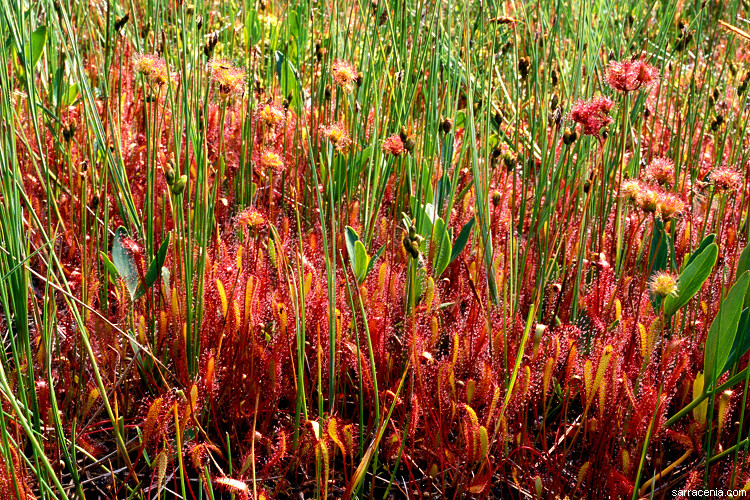
Abnormal flowers:
Ah! Here is a close view of the fuzzy-looking plants, and immediately
you can see why they look so odd--the flowers in the inflorescences have been replaced with plantlets. This is referred to
as false vivipary.
This kind of behavior is not exceedingly rare in the Droseraceae. It is occasionally seen in the closely related plant
Drosera intermedia (see, for example,
this image or this image of plants in
North Carolina) and of course it can
be quite spectacularly seen in Dionaea muscipula.
It is largely of mystery as to why plants sometimes
produce such plantlets on their flower stalks. Conventional wisdom is that it is motivated by
some as-yet-unknown stimulus such as frosts or other climate variations.
However, the manifestation of this phenomenon at this Oregon lake was
intriguing. The large Sphagnum mat was covered with normally flowering plants. Yet, scattered here and there were
clumps of plants in which all (or nearly all) the plants were producing flower-plantlets, as show in the above
photograph. These abnormal plants were in well-defined clumps or clusters.
The situation strongly reminded me of locations I have seen where Drosera anglica
and Drosera rotundifolia occur together and hybridize to create Drosera × obovata.
In such settings, the sterile
Drosera ×obovata would form vigorous, dense clumps of plants as they reproduced vegetatively. I wondered,
could it be that the falsely-viviparous
Drosera anglica in these clumps were genetically fixed to produce only vegetative flowers?
It was unlikely, for certain, but the evidence before my eyes was certainly evocative.
If, on the other hand,
the production of vegetative flowers was stimulated by some other impetus such as climatic variations,
how could the clumping nature
of the phenomenon be explained in this case? After all, this uniform Sphagnum mat was extremely spatially
homogenous. What kind of stimulus could be so clumped in its impact? Could climatic variations be some inhomogenous
over such tiny ranges, in such an extremely homogenous setting? Perhaps could it be methane coming out of the peat,
the kind of methane that in more violent eruptions caused complete disruption of the mat?
Incidentally, it is worthwhile to note that the leaves of these plants are very long and narrow, quite unlike the leaves
of the plants I had just recently been seeing at Tranquil Basin (Idaho).